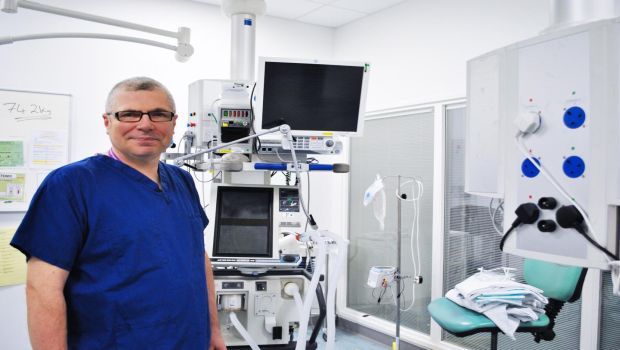New Breath Test for Pneumonia is Developed
Researchers from the University of Manchester are part of a team that has identified an important new approach to diagnose infections in critically ill patients rapidly and accurately. A study by colleagues in Salford and Manchester found that chemically analyzing breath specimens from patients in intensive care can reveal bacterial infection in the lower respiratory tract of ventilated patients at risk of developing pneumonia.


Dr. Paul Dark. Photo courtesy of Salford Royal NHS Foundation Trust
Researchers from the University of Manchester are part of a team that has identified an important new approach to diagnose infections in critically ill patients rapidly and accurately. A study by colleagues in Salford and Manchester found that chemically analyzing breath specimens from patients in intensive care can reveal bacterial infection in the lower respiratory tract of ventilated patients at risk of developing pneumonia.
Although the work is in its early stages, the findings so far look very exciting and could potentially have a huge effect on clinical practice as healthcare associated infections are a major issue worldwide.
The unique 'first in man' project was carried out at Salford Royal NHS Foundation Trust, The University of Manchester Centre for Respiratory Medicine and Allergy, and the Manchester Institute of Biotechnology (MIB) and was a proof-of-concept study that has provided significant evidence leading to a larger research programme involving patients across Greater Manchester.
Dr. Paul Dark, one of the research team and Honorary Consultant in intensive care medicine at Salford Royal, explains, "When patients come into hospital, their safety is absolutely crucial. We know that one of the most significant risks is that they develop an infection and patients in critical care are the most vulnerable because they are very ill and we have to use lots of interventions and invasive techniques. We have to provide the very highest quality safety measures for them, but despite that, some patients do still get infections and one of the most common is respiratory tract infection, especially pneumonia. Pneumonias are caused by microbes that can be treated with antibiotics, but there are two major problems -- pneumonia can be difficult to detect and diagnose and because of that, we tend to use potent broad spectrum antibiotics in anyone who shows symptoms of infection. This might not be necessary, so is wasting NHS resources, but the bigger picture is that we could be seeding antibiotic resistance -- a huge worldwide issue."
Current methods of confirming the presence of infections involve laboratory tests of samples from deep in the lungs, which can take days.
Dr. Stephen Fowler, clinical lecturer in the University's Centre for Respiratory Medicine and Allergy based at the University Hospital of South Manchester NHS Foundation Trust, says, "Now we know that it's feasible to capture and measure breath chemicals of patients on mechanical ventilators, we plan to develop a simple non-invasive system that will be part of the normal connections on the machine. We have attracted National Institute for Health Research Invention for Innovation funding for the next three years to work on this. Our findings so far have been very exciting and we are optimistic that this research will be of real impact clinically."
Roy Goodacre, who is a professor in the School of Chemistry at the University of Manchester and who works in the MIB, adds, "In the setting of complex clinical questions, this innovative project highlights how the application of state-of-the-art chemical analysis and bioinformatics can provide opportunities to deliver patient safety and improve human health on a global scale."
An article based on the research, "Surveillance for lower airway pathogens in mechanically ventilated patients by metabolomics analysis of exhaled breath: a case-control study," has been published in the journal Thorax. The article is available at: http://thorax.bmj.com/content/70/4/320.full
Source: University of Manchester
IDEA in Action: A Strategic Approach to Contamination Control
January 14th 2025Adopting IDEA—identify, define, explain, apply—streamlines contamination control. Infection control professionals can mitigate risks through prevention, intervention, and training, ensuring safer health care environments and reducing frequent contamination challenges.
Balancing Freedom and Safety: When Public Health Mandates Are Necessary
January 9th 2025Public health mandates, such as lockdowns, masking, and vaccination, balance liberty and safety, ensuring critical protections during pandemics like COVID-19 while fostering long-term survival through science.
Long-Term Chronicles: Infection Surveillance Guidance in Long-Term Care Facilities
January 8th 2025Antibiotic stewardship in long-term care facilities relies on McGeer and Loeb criteria to guide infection surveillance and appropriate prescribing, ensuring better outcomes for residents and reducing resistance.
Considering Avian Flu: World Health Organization Expert Warns Against Raw Milk
January 6th 2025Drinking raw milk poses risks of disease transmission, especially with H5N1 outbreaks. Expert Richard J. Webby, PhD, advises against raw cow or goat milk consumption due to its unpredictable and significant risks.